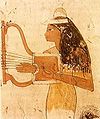Ointment cones
Ointment cones were conical structures, presumably made from oils, resins and fats, which in ancient Egypt were worn on certain occasions, either on a wig or on a shaved head.
It is believed that the ointment cones were used to diffuse fragrance. A well-known ingredient was behen oil . They probably also contained myrrh and should have melted slowly with the body heat.
Pictorial representation
For the first time, ointment cones were demonstrated in the reign of Hatshepsut in depictions of the banquet and funeral supper scene. Later they also appear in other motifs in the context of religious scenes and funeral scenes. From the 3rd interim period, the depiction of the cones is limited to scenes of the worship of gods. The shape of the ointment cones varied during the 18th and 19th dynasties, so that it is possible to date the representations. From the 20th dynasty, the representation is reduced to a stereotypical form.
Priest Renpetmaa with anointing cone before Re-Harachte (approx. 900 BC)
literature
- Monika Silke Randl: The development of the ointment cones in the flat. Diploma thesis, University of Vienna 2008 ( abstract )
Web links
Individual evidence
- ^ Rainer Hannig: Large Concise Dictionary Egyptian-German: (2800-950 BC) . von Zabern, Mainz 2006, ISBN 3-8053-1771-9 , p. 258.
- ↑ Monika Silke Randl: The development of the ointment cones in the flat. Diploma thesis, University of Vienna 2008




